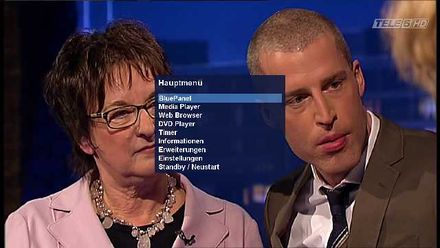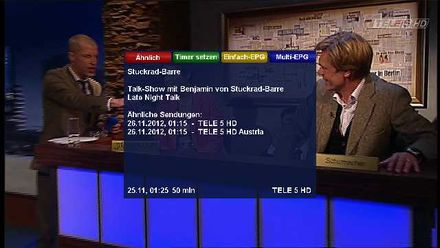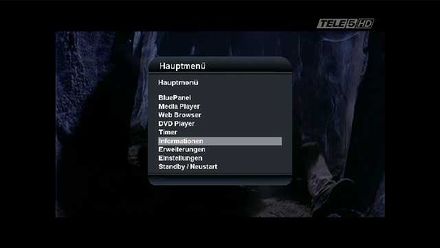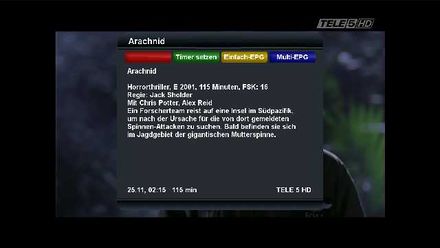First basics for a skin (en): Unterschied zwischen den Versionen
Mfgeg (Diskussion | Beiträge) |
Mfgeg (Diskussion | Beiträge) |
||
| (8 dazwischenliegende Versionen von 2 Benutzern werden nicht angezeigt) | |||
| Zeile 8: | Zeile 8: | ||
* serves a basis for the <code>skin.xml</code> | * serves a basis for the <code>skin.xml</code> | ||
| − | |||
* and can be startet without crash | * and can be startet without crash | ||
| − | |||
| − | |||
| − | |||
| Zeile 35: | Zeile 31: | ||
| − | The <code>skin.xml</code> in [[OE 2.0]], must contain following items to be bootable and not causing a [[Green Screen| | + | The <code>skin.xml</code> in [[OE 2.0]], must contain following items to be bootable and not causing a [[Green Screen|crash]]: |
* the definition of the skins '''<skin> </skin>''' | * the definition of the skins '''<skin> </skin>''' | ||
| Zeile 111: | Zeile 107: | ||
|} | |} | ||
| − | |||
| − | |||
== Background knowledge skin.xml == | == Background knowledge skin.xml == | ||
| Zeile 120: | Zeile 114: | ||
The XML works with markups and the skin is started by the first tag '''<skin>''', and stopped with '''</skin>''' | The XML works with markups and the skin is started by the first tag '''<skin>''', and stopped with '''</skin>''' | ||
| − | In between all other markups are listed. Allways following the same scheme, the markup starts with the starttag '''<markupstart>''' and ends with an endtag '''</markupend>''' with a forward slash '''/'''. | + | In between all other markups are listed. Allways following the same scheme, the markup starts with the starttag '''<markupstart>''' and ends with an endtag '''</markupend>''' with a forward slash '''/''' after the first angle bracket. |
| − | + | === Comments === | |
| − | + | Comments can be added as follows: | |
| − | |||
| − | |||
| − | |||
<syntaxhighlight lang="xml"> | <syntaxhighlight lang="xml"> | ||
| − | <!-- | + | <!-- this is a comment --> |
| − | <!-- | + | <!-- with these characters a comment starts |
| − | + | and will only end | |
| − | + | when these | |
| − | + | characters are set --> | |
</syntaxhighlight> | </syntaxhighlight> | ||
| − | + | Of course this can also be used to "disable" some lines in the <code>skin.xml</code>, to avoid some parts to be read at the start. This can be useful while skinning and testing. | |
| − | |||
| − | |||
| − | |||
| − | + | === Markups === | |
| − | === | ||
<syntaxhighlight lang="xml"> | <syntaxhighlight lang="xml"> | ||
| − | <!-- | + | <!-- The output markup defines the following --> |
| − | <output id="0"> <!-- | + | <output id="0"> <!-- where the output is displayed, id="0" is the TV screen, (id=1 LCD), (id=2 Color OLED (dm800se) --> |
| − | <resolution xres="1280" yres="720" bpp="32" /> <!-- | + | <resolution xres="1280" yres="720" bpp="32" /> <!-- The size / resolution of the skin --> |
| − | </output> <!-- | + | </output> <!-- end of the output markup --> |
</syntaxhighlight> | </syntaxhighlight> | ||
<syntaxhighlight lang="xml"> | <syntaxhighlight lang="xml"> | ||
| − | <!-- | + | <!-- The color markup are using the HTML-color codes to assing a specific color --> |
| − | <colors> <!-- | + | <colors> <!-- markup start --> |
<color name="black" value="#000000"/> | <color name="black" value="#000000"/> | ||
<color name="white" value="#ffffff"/> | <color name="white" value="#ffffff"/> | ||
| − | <!-- | + | <!-- by assigning the color we can use a name for colors in the skin |
| − | + | this way we don't need to look up the code every time --> | |
| − | </colors> <!-- | + | </colors> <!-- markup end --> |
</syntaxhighlight> | </syntaxhighlight> | ||
<syntaxhighlight lang="xml"> | <syntaxhighlight lang="xml"> | ||
| − | <!-- Fonts | + | <!-- Fonts --> |
<fonts> | <fonts> | ||
<font filename="nmsbd.ttf" name="Regular" scale="100"/> | <font filename="nmsbd.ttf" name="Regular" scale="100"/> | ||
| Zeile 172: | Zeile 159: | ||
<font filename="ae_AlMateen.ttf" name="Replacement" scale="100" replacement="1"/> | <font filename="ae_AlMateen.ttf" name="Replacement" scale="100" replacement="1"/> | ||
<font filename="tuxtxt.ttf" name="Console" scale="100"/> | <font filename="tuxtxt.ttf" name="Console" scale="100"/> | ||
| − | <!-- | + | <!-- These are the standard fonts, other fonts can be installed if you want to use alternatives --> |
</fonts> | </fonts> | ||
</syntaxhighlight> | </syntaxhighlight> | ||
| Zeile 179: | Zeile 166: | ||
<syntaxhighlight lang="xml"> | <syntaxhighlight lang="xml"> | ||
<!-- Main screen colors (id=0 Framebuffer) --> | <!-- Main screen colors (id=0 Framebuffer) --> | ||
| − | <!-- | + | <!-- Here the colors for the different screen elements are defined together with the font and the size --> |
<windowstyle type="skinned" id="0"> | <windowstyle type="skinned" id="0"> | ||
<title offset="15,9" font="Regular;26" /> | <title offset="15,9" font="Regular;26" /> | ||
| Zeile 197: | Zeile 184: | ||
</syntaxhighlight> | </syntaxhighlight> | ||
| − | + | If you want to use framed screens, take a look in the <code>skin.xml</code> of the Default-HD to see the structure: | |
| − | + | This is also a submarkup which needs to be added to the markup '''windowstyle'''!! | |
<syntaxhighlight lang="xml"> | <syntaxhighlight lang="xml"> | ||
| Zeile 215: | Zeile 202: | ||
</syntaxhighlight> | </syntaxhighlight> | ||
| − | + | Completed this would look like the '''Default-HD''' skin. If you want different graphics, you need to create some with an editor. | |
| + | === Screens (windows) === | ||
| − | + | Windows or screens will be explained in detail later, but heres some basics already. | |
| − | |||
| − | |||
| − | |||
| − | |||
| − | |||
| − | |||
<syntaxhighlight lang="xml"> | <syntaxhighlight lang="xml"> | ||
| − | <!-- | + | <!-- a simple screen starts with "<screen" and ends with "/>" --> |
<screen name="SubtitleDisplay" position="0,0" size="1280,720" zPosition="-1" flags="wfNoBorder" backgroundColor="transparent"/> | <screen name="SubtitleDisplay" position="0,0" size="1280,720" zPosition="-1" flags="wfNoBorder" backgroundColor="transparent"/> | ||
</syntaxhighlight> | </syntaxhighlight> | ||
<syntaxhighlight lang="xml"> | <syntaxhighlight lang="xml"> | ||
| − | <!-- | + | <!-- an advanced screen starts with "<screen" --> |
<screen name="MoviePlayer" position="0,561" size="1280,133" title="InfoBar" backgroundColor="transparent" flags="wfNoBorder" | <screen name="MoviePlayer" position="0,561" size="1280,133" title="InfoBar" backgroundColor="transparent" flags="wfNoBorder" | ||
<ePixmap pixmap="Default-HD/icons/icon_event.png" position="60,20" size="20,13" alphatest="on" /> | <ePixmap pixmap="Default-HD/icons/icon_event.png" position="60,20" size="20,13" alphatest="on" /> | ||
| Zeile 238: | Zeile 220: | ||
<convert type="ServiceName">Name</convert> | <convert type="ServiceName">Name</convert> | ||
</widget> | </widget> | ||
| − | </screen> <!-- | + | </screen> <!-- ends like this! --> |
| − | <!-- | + | <!-- because in an advanced screen you can integrate different graphics, labels and widgets --> |
</syntaxhighlight> | </syntaxhighlight> | ||
| Zeile 245: | Zeile 227: | ||
Back to top [[#top | TOC:]] | Back to top [[#top | TOC:]] | ||
| − | |||
| − | + | Now you know the minimal configuration, you can change the <code>skin.xml</code> like this: | |
| − | * | + | * add a personal graphic '''"borderset"''' to change the look of the windows |
| − | * | + | * addapt the colors as wanted |
| − | + | It can be like this: | |
<syntaxhighlight lang="xml"> | <syntaxhighlight lang="xml"> | ||
| Zeile 331: | Zeile 312: | ||
</syntaxhighlight> | </syntaxhighlight> | ||
| − | + | Restart [[Enigma2]] again to activate the changes: | |
{| | {| | ||
| − | |[[Bild:skin_minimal_Hauptmenue_BlackdreamHD.jpg|left|thumb|440px| | + | |[[Bild:skin_minimal_Hauptmenue_BlackdreamHD.jpg|left|thumb|440px|Minimal main menu without extra graphics]] || |
| − | |[[Bild:skin_minimal_infoscreen_BlackdreamHD.jpg|right|thumb|440px| | + | |[[Bild:skin_minimal_infoscreen_BlackdreamHD.jpg|right|thumb|440px|Info window, the buttons come from the default skin]] || |
|} | |} | ||
| − | + | other menu windows - such as the settings, mediaplayer, ... - will remain in the default skin because no changes were made. | |
| − | |||
| − | |||
| − | |||
| − | |||
| − | |||
| − | |||
| − | |||
| − | |||
| − | |||
| − | |||
| − | + | == Readability of the skin.xml == | |
| − | + | It's clear we need the skin.xml (as with all other scrips, programms,....) to be structured to have a good readability. | |
| − | + | This is not only a help for new skinners, but helps also to find errors. | |
| + | Comments should be used with moderation, but use them to keep the skin.xml readable. | ||
| − | + | As the basic skin is now running without [[Green Screen|crash]] we can continue. | |
| + | Here we follow a personal '''structure and sequence''' which is '''only''' a guideline! | ||
| − | |||
| + | Here you can recognise the "signature" of skinners and mods... | ||
| − | [[Kategorie:Enigma2 (en) | + | [[Kategorie:Enigma2 Skins (en)]] |
| − | |||
| − | |||
| − | |||
Aktuelle Version vom 8. September 2013, 10:38 Uhr
Inhaltsverzeichnis
Introduction
This article explains the basics for a skin, which meets following conditions:
- serves a basis for the
skin.xml - and can be startet without crash
Your first skin.xml
The skin.xml is a file which influences the behaviour of the skin.
Normally this is the place where most of the screens are "skinned", the screens which were not skinned will be displayed using the "default-skin".
This means the structure of the Defaultskins is a good stating point for skinning. Also if something is changed in the OE 2.0 images, the Defaultskin should be the first skin which displays the new functions without problems. With the introduction of the new OE 2.0 a new HD skin Default-HD was introduced. It's allways a good idea to take a look at this one.
Later you can check the differences in the skins, look into the details and see what change is causing a specific change.
| The skin.xml can be found in: usr/share/enigma2/ in the corresponding directory of the installed skin. |
To start with your first skin which will start(without graphics, ...). Create following items in usr/share/enigma2/:
- a new directory for your new skin (in this example we use BlackdreamHD)
- a file
skin.xmlwith minimal content (from the Skin Default-HD)
The skin.xml in OE 2.0, must contain following items to be bootable and not causing a crash:
- the definition of the skins <skin> </skin>
- the definition of the resolution <output id="0"> </output>
- the definition the colors <colors> </colors>
- the definition the fonts <fonts> </fonts> (was not needed in OE 1.6)
- the definition of the window colors <windowstyle> </windowstyle>
<skin> <!-- Head for Image resolution --> <output id="0"> <resolution xres="1280" yres="720" bpp="32" /> </output> <!-- Colors (#AARRGGBB) --> <colors> <color name="black" value="#000000"/> <color name="white" value="#ffffff"/> <color name="grey" value="#b3b3b9"/> <color name="grey2" value="#d3d3d9"/> <color name="dark" value="#20062748"/> <color name="menu" value="#20062748"/> <color name="red" value="#f23d21"/> <color name="green" value="#389416"/> <color name="blue" value="#0064c7"/> <color name="yellow" value="#bab329"/> <color name="transparent" value="#ff000000"/> <color name="transpBlack" value="#80000000"/> <color name="transpWhite" value="#80ffffff"/> <color name="background" value="#200d1940"/> <color name="foreground" value="#ffffff"/> </colors> <!-- Fonts --> <fonts> <font filename="nmsbd.ttf" name="Regular" scale="100"/> <font filename="lcd.ttf" name="LCD" scale="100"/> <font filename="ae_AlMateen.ttf" name="Replacement" scale="100" replacement="1"/> <font filename="tuxtxt.ttf" name="Console" scale="100"/> </fonts> <!-- Main screen colors (id=0 Framebuffer) --> <windowstyle type="skinned" id="0"> <title offset="15,9" font="Regular;26" /> <color name="Background" color="#200d1940"/> <color name="LabelForeground" color="#ffffff"/> <color name="ListboxBackground" color="#200d1940"/> <color name="ListboxForeground" color="#ffffff"/> <color name="ListboxSelectedBackground" color="#204176b6"/> <color name="ListboxSelectedForeground" color="#ffffff"/> <color name="ListboxMarkedBackground" color="#200d1940"/> <color name="ListboxMarkedForeground" color="#00ff00"/> <color name="ListboxMarkedAndSelectedBackground" color="#204176b6"/> <color name="ListboxMarkedAndSelectedForeground" color="#00ff00"/> <color name="WindowTitleForeground" color="#ffffff"/> <color name="WindowTitleBackground" color="#16244b"/> </windowstyle> </skin>
Now we have no infobar and zapping occurs blind. Also the menu is very rudimentary.
But the goal was to create a minimal skin which will not crash.
Background knowledge skin.xml
As the name of the skin.xml suggests, the structure of a skin is composed in a scripting language, with the name XML.
The XML works with markups and the skin is started by the first tag <skin>, and stopped with </skin>
In between all other markups are listed. Allways following the same scheme, the markup starts with the starttag <markupstart> and ends with an endtag </markupend> with a forward slash / after the first angle bracket.
Comments
Comments can be added as follows:
<!-- this is a comment --> <!-- with these characters a comment starts and will only end when these characters are set -->
Of course this can also be used to "disable" some lines in the skin.xml, to avoid some parts to be read at the start. This can be useful while skinning and testing.
Markups
<!-- The output markup defines the following --> <output id="0"> <!-- where the output is displayed, id="0" is the TV screen, (id=1 LCD), (id=2 Color OLED (dm800se) --> <resolution xres="1280" yres="720" bpp="32" /> <!-- The size / resolution of the skin --> </output> <!-- end of the output markup -->
<!-- The color markup are using the HTML-color codes to assing a specific color --> <colors> <!-- markup start --> <color name="black" value="#000000"/> <color name="white" value="#ffffff"/> <!-- by assigning the color we can use a name for colors in the skin this way we don't need to look up the code every time --> </colors> <!-- markup end -->
<!-- Fonts --> <fonts> <font filename="nmsbd.ttf" name="Regular" scale="100"/> <font filename="lcd.ttf" name="LCD" scale="100"/> <font filename="ae_AlMateen.ttf" name="Replacement" scale="100" replacement="1"/> <font filename="tuxtxt.ttf" name="Console" scale="100"/> <!-- These are the standard fonts, other fonts can be installed if you want to use alternatives --> </fonts>
<!-- Main screen colors (id=0 Framebuffer) --> <!-- Here the colors for the different screen elements are defined together with the font and the size --> <windowstyle type="skinned" id="0"> <title offset="15,9" font="Regular;26" /> <color name="Background" color="#200d1940"/> <color name="LabelForeground" color="#ffffff"/> <color name="ListboxBackground" color="#200d1940"/> <color name="ListboxForeground" color="#ffffff"/> <color name="ListboxSelectedBackground" color="#204176b6"/> <color name="ListboxSelectedForeground" color="#ffffff"/> <color name="ListboxMarkedBackground" color="#200d1940"/> <color name="ListboxMarkedForeground" color="#00ff00"/> <color name="ListboxMarkedAndSelectedBackground" color="#204176b6"/> <color name="ListboxMarkedAndSelectedForeground" color="#00ff00"/> <color name="WindowTitleForeground" color="#ffffff"/> <color name="WindowTitleBackground" color="#16244b"/> </windowstyle>
If you want to use framed screens, take a look in the skin.xml of the Default-HD to see the structure:
This is also a submarkup which needs to be added to the markup windowstyle!!
<!-- screen border png's --> <borderset name="bsWindow"> <pixmap pos="bpTopLeft" filename="Default-HD/b_tl.png" /> <pixmap pos="bpTop" filename="Default-HD/b_t.png" /> <pixmap pos="bpTopRight" filename="Default-HD/b_tr.png" /> <pixmap pos="bpLeft" filename="Default-HD/b_lr.png" /> <pixmap pos="bpRight" filename="Default-HD/b_lr.png" /> <pixmap pos="bpBottomLeft" filename="Default-HD/b_bl.png" /> <pixmap pos="bpBottom" filename="Default-HD/b_b.png" /> <pixmap pos="bpBottomRight" filename="Default-HD/b_br.png" /> </borderset>
Completed this would look like the Default-HD skin. If you want different graphics, you need to create some with an editor.
Screens (windows)
Windows or screens will be explained in detail later, but heres some basics already.
<!-- a simple screen starts with "<screen" and ends with "/>" --> <screen name="SubtitleDisplay" position="0,0" size="1280,720" zPosition="-1" flags="wfNoBorder" backgroundColor="transparent"/>
<!-- an advanced screen starts with "<screen" --> <screen name="MoviePlayer" position="0,561" size="1280,133" title="InfoBar" backgroundColor="transparent" flags="wfNoBorder" <ePixmap pixmap="Default-HD/icons/icon_event.png" position="60,20" size="20,13" alphatest="on" /> <widget source="session.CurrentService" render="Label" position="100,12" size="850,27" font="Regular;24" valign="top" noWrap="1" backgroundColor="#263c59" transparent="1"> <convert type="ServiceName">Name</convert> </widget> </screen> <!-- ends like this! --> <!-- because in an advanced screen you can integrate different graphics, labels and widgets -->
Back to top TOC:
Now you know the minimal configuration, you can change the skin.xml like this:
- add a personal graphic "borderset" to change the look of the windows
- addapt the colors as wanted
It can be like this:
<skin> <!-- Skin: BlackDreamHD for OE2.0 by EgLe (c)2012 --> <!-- This skin skin and all it's graphics are free. Everyone can modify and use it in other images. --> <!-- Spezial Thanks to Kerni and Vali for his great Skins, Renderer,Converter and Wonderfull Idea --> <!-- BUT DO NOT REMOVE OR CHANGE THE SECOND LINE !!! --> <!-- Head for Image resolution --> <output id="0"> <resolution xres="1280" yres="720" bpp="32" /> </output> <!-- Colors (#AARRGGBB) --> <colors> <color name="white" value="#ffffff" /> <color name="black" value="#000000" /> <color name="dark" value="#25062748" /> <color name="red" value="#f23d21" /> <color name="green" value="#5bac3f" /> <color name="blue" value="#21b0cf" /> <color name="grey" value="#90a0a0" /> <color name="yellow" value="#00e5b243" /> <color name="lightgrey" value="#8c8c93" /> <color name="darkgrey" value="#777777" /> <color name="transparent" value="#ffffffff" /> <color name="transpBlack" value="#80000000" /> <color name="transpWhite" value="#80ffffff" /> <color name="transpyellow" value="#33bab329" /> <color name="background" value="#25272d33" /> <color name="foreground" value="#ffffff" /> <color name="foreyellow" value="#cc9329" /> </colors> <!-- Fonts --> <fonts> <font filename="nmsbd.ttf" name="Regular" scale="95" /> <font filename="lcd.ttf" name="LCD" scale="100" /> <font filename="ae_AlMateen.ttf" name="Replacement" scale="95" replacement="1" /> <font filename="tuxtxt.ttf" name="Console" scale="100" /> </fonts> <!-- Main screen colors (id=0 Framebuffer) --> <windowstyle type="skinned" id="0"> <title offset="33,14" font="Regular;27" /> <color name="Background" color="#272d33" /> <color name="LabelForeground" color="#ffffff" /> <color name="ListboxBackground" color="#272d33" /> <color name="ListboxForeground" color="#ffffff" /> <color name="ListboxSelectedBackground" color="#8c8c93" /> <color name="ListboxSelectedForeground" color="#ffffff" /> <color name="ListboxMarkedBackground" color="#2a2d2f" /> <color name="ListboxMarkedForeground" color="#389416" /> <color name="ListboxMarkedAndSelectedBackground" color="#2a2d2f" /> <color name="ListboxMarkedAndSelectedForeground" color="#f23d21" /> <color name="WindowTitleForeground" color="#ffffff" /> <color name="WindowTitleBackground" color="#232a33" /> <!-- Main screen border png's --> <borderset name="bsWindow"> <pixmap pos="bpTopLeft" filename="BlackDreamHD/b_tl.png" /> <pixmap pos="bpTop" filename="BlackDreamHD/b_t.png" /> <pixmap pos="bpTopRight" filename="BlackDreamHD/b_tr.png" /> <pixmap pos="bpLeft" filename="BlackDreamHD/b_l.png" /> <pixmap pos="bpRight" filename="BlackDreamHD/b_r.png" /> <pixmap pos="bpBottomLeft" filename="BlackDreamHD/b_bl.png" /> <pixmap pos="bpBottom" filename="BlackDreamHD/b_b.png" /> <pixmap pos="bpBottomRight" filename="BlackDreamHD/b_br.png" /> </borderset> </windowstyle> </skin>
Restart Enigma2 again to activate the changes:
other menu windows - such as the settings, mediaplayer, ... - will remain in the default skin because no changes were made.
Readability of the skin.xml
It's clear we need the skin.xml (as with all other scrips, programms,....) to be structured to have a good readability.
This is not only a help for new skinners, but helps also to find errors.
Comments should be used with moderation, but use them to keep the skin.xml readable.
As the basic skin is now running without crash we can continue.
Here we follow a personal structure and sequence which is only a guideline!
Here you can recognise the "signature" of skinners and mods...



